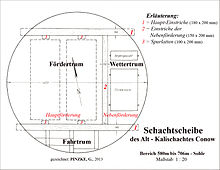Trum (mining)
In mining, a vertical section of a shaft is referred to as a strand . The dreams are once Riche separated. The guide rails and other manhole fittings are attached to the grooves.
"Trum (multiple dreams or ruins) ... In mining, each of the sections of a shaft formed by carpentry or masonry, hence the names that correspond to their purpose: conveying, driving, weather, pumping center."
The main strand of a shaft is called the conveyor strand, in which the conveyor racks move up and down. In the driving or driving center are the journeys that used to be used by miners to drive in and out before the introduction of the passenger cable car. Some of today's shafts no longer have a drive section because they are either too deep to climb the drives or have several independent conveyor sections, so that the miners can also be extended in an emergency. If there is a trip, it is only used for emergency travel.
If the shaft is both moving in and out, the moving in and out weather strands are separated from one another with a weather separator . This is a weatherproof cladding, usually consisting of boards covered with a weather cloth , sometimes also bricked, which ensures that the incoming fresh weather does not mix with the moving weather. Since all mines are now open for at least two days , one of them is usually drawn in and the other (s) drawn out. As a result, the weather separator has lost its importance.
Further dreams are the pipe and cable runs, sometimes also a combined pipe and cable run. They are used to supply the mine with energy and for water retention - there are both downpipes and risers in the pipe run.
The art dream is still of historical importance. In it, the art of pumps moved up and down, which drove the piston pumps, which were installed at regular intervals. This design has not been used since the invention of centrifugal pumps and pressure-tight pipes. The linkage was also used in some mines for driving skills .
